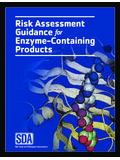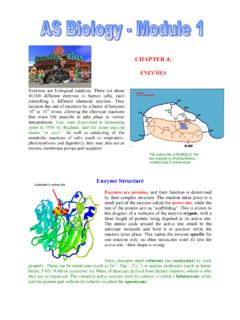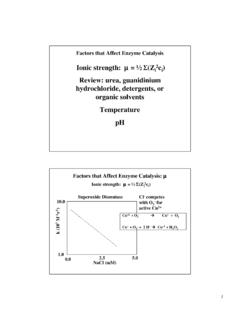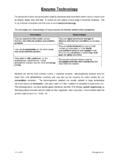Transcription of Enzyme Kinetics - University Science Books - Home Page
1 CHAPTER10 Enzyme KineticsOne of the most fascinating areas of study in chemical Kinetics is Enzyme phenomenon of Enzyme catalysis usually results in a very large increase in reac-tion rate (on the order of 106to 1018) and high specificity. By specificity, we meanthat an Enzyme molecule is capable of selectively catalyzing certain reactants, calledsubstrates, while discriminating against other chapter presents the basic mathematical treatment of Enzyme Kinetics anddiscusses the topics of Enzyme inhibition, allosterism, and the e ect of pH on General Principles of CatalysisAcatalystis a substance that increases the rate of a reaction without itself beingconsumed by the process. A reaction in which a catalyst is involved is called acata-lyzed reaction, and the process is calledcatalysis. In studying catalysis, keep in mindthe following characteristics:1. A catalyst lowers the Gibbs energy of activation by providing a di erentmechanism for the reaction (Figure ).
2 This mechanism enhances therate and it applies toboththe forward and the reverse directions of coordinateGibbs energyReactantsProducts GReaction coordinateGibbs energyReactantsProducts G(a)(b) rG rG Figure energy change for (a) an uncatalyzed reaction and (b) a catalyzed reaction. Acatalyzed reaction must involve the formation of at least one intermediate (between thereactant and the catalyst). TheDrG is the same in both A catalyst forms an intermediate with the reactant(s) in the initial step of themechanism and is released in the product-forming step. The catalyst doesnot appear in the overall Regardless of the mechanism and the energetics of a reaction, a catalystcannot a ect the enthalpies or Gibbs energies of the reactants andproducts. Thus, catalysts increase the rate of approach to equilibrium, butcannot alter the thermodynamic equilibrium have used catalysts for thousands of years in food preparation and winemaking. Industrially, hundreds of billions of dollars worth of chemicals are producedannually with the aid of catalysts.
3 There are three types of catalysis: heterogeneous,homogeneous, and enzymatic. In a heterogeneously catalyzed reaction, the reactantsand the catalyst are in di erent phases (usually gas/solid or liquid/solid). Well-knownexamples are the Haber synthesis of ammonia and the Ostwald manufacture of nitricacid. The bromination of acetone, catalyzed by acids,CH3 COCH3 Br2 !H CH2 BrCOCH3 HBris an example of homogeneous catalysis because the reactants and the catalyst H are all present in the aqueous medium. Enzyme catalysis is also mostly homogeneousin nature. However, because it is of biological origin and is the most complex of thethree types of catalysis, Enzyme catalysis is treated as a separate category. Whether ornot their mechanisms are well understood, enzymes have been used widely in foodand beverage production, as well as in the manufacture of drugs and other CatalysisSince 1926, when the American biochemist James Sumner (1887 1955) crystal-lized urease (an Enzyme that catalyzes the cleavage of urea to ammonia and carbondioxide), it has come to be known that most enzymes are proteins.
4 * An enzymeusually contains one or moreactive sites, where reactions with substrates take active site may comprise only a few amino acid residues; the rest of the protein isrequired for maintaining the three-dimensional integrity of the network. The specif-icity of enzymes for substrates varies from molecule to molecule. Many enzymes ex-hibit stereochemical specificity in that they catalyze the reactions of one conforma-tion but not the other (Figure ). For example, proteolytic enzymes catalyze only* In the early 1980s, chemists discovered that certain RNA molecules, called ribozymes, alsopossess catalytic binding siteEnzyme binding site11223344 Figure showing how two enantiomers bind di erentlyto an Enzyme . Because the geometry of an Enzyme s activesite is normally fixed (that is, it can have only one of theabove two arrangements), a reaction occurs for only oneof the two enantiomers. Specificity requires a minimum ofthree contact points between the substrate and the 10: Enzyme Kineticsthe hydrolysis of peptides made up ofl-amino acids.
5 Some enzymes are catalyticallyinactive in the absence of certain metal the 1890s the German chemist Emil Fischer (1852 1919) proposed a lock-and-key theory of Enzyme specificity. According to Fischer, the active site can be assumedto have a rigid structure, similar to a lock. A substrate molecule then has a comple-mentary structure and functions as a key. Although appealing in some respects, thistheory has been modified to take into account the flexibility of proteins in now know that the binding of the substrate to the Enzyme results in a distortionof the substrate into the conformation of the transition state. At the same time, theenzyme itself also undergoes a change in conformation to fit the substrate ( ). The flexibility of the protein also explains the phenomenon of the binding of a substrate to an Enzyme with multiple bindingsites can alter the substrate s a nity for Enzyme binding at its other , like other catalysts, increase the rate of a reaction.
6 An understandingof the e ciency of enzymes can be gained by examining Equation :k kBThe DG z=RT M1 m kBTheDS z=Re DH z=RT M1 m There are two contributions to the rate constant:DH zandDS z. The enthalpy ofactivation is approximately equal to the energy of activation Ea in the Arrheniusequation (see Equation ). Certainly a reduction inEaby the action of a cata-lyst would enhance the rate constant. In fact, this is usually the explanation of howa catalyst works, but it is not always true for Enzyme catalysis. Entropy of activa-tion,DS z, may also be an important factor in determining the e ciency of the bimolecular reactionA B!ABz!productFigure conformational change that occurs when glucose binds to hexokinase, which is anenzyme in the metabolic pathway. [From W. S. Bennet and T. A. Steitz,J. Mol. ,211 (1980).] General Principles of Catalysis365where A and B are both nonlinear molecules. Before the formation of the activatedcomplex, each A or B molecule has three translational, three rotational, and threevibrational degrees of freedom.
7 These motions all contribute to the entropy of themolecule. At 25 C, the greatest contribution comes from translational motion (about120 J K 1mol 1), followed by rotational motion (about 80 J K 1mol 1). Vibra-tional motion makes the smallest contribution (about 15 J K 1mol 1). The transla-tional and rotational entropies of the activated complex are only slightly larger thanthose of an individual A or B molecule (these entropies increase slowly with size);therefore, there is a net loss in entropy of about 200 J K 1mol 1when the activatedcomplex is formed. This loss in entropy is compensated for to a small extent by newmodes of internal rotation and vibration in the activated complex. For unimolecularreactions, such as thecis transisomerization of an alkene, however, there is verylittle entropy change because the activated complex is formed from a single molecularspecies. A theoretical comparison of a unimolecular reaction with a bimolecular oneshows a di erence of as much as 3 1010in theeDS z=Rterm, favoring the unim-olecular a simple Enzyme -catalyzed reaction in which one substrate (S) is trans-formed into one product (P).
8 The reaction proceeds as follows:E S ES ESz EP E PIn this scheme, the Enzyme and the substrate must first encounter each other in so-lution to form the Enzyme substrate intermediate, ES. This is a reversible reactionbut when [S] is high, the formation of ES is favored. When the substrate is bound,forces within the active site can align the substrate and Enzyme reactive groups intoproper orientation, leading to the activated complex. The reaction takes place in thesingle entity Enzyme substrate intermediate to form the Enzyme substrate activatedcomplex ESz , as in a unimolecular reaction, so the loss in entropy will be much other words, the loss of the translational and rotational entropies occurred duringthe formation of ES, and not during the ES!ESzstep. (This loss of entropy islargely compensated for by the substrate binding energy.) Once formed, ESzproceedsenergetically downhill to the Enzyme product intermediate and finally to the productwith the regeneration of the Enzyme .
9 Figure summarizes the steps on a diagramof Gibbs energy versus reaction The Equations of Enzyme KineticsIn Enzyme Kinetics , it is customary to measure theinitial rate v0 of a reaction tominimize reversible reactions and the inhibition of enzymes by products. Further-ESEPR eaction coordinateGibbs energyESE SE PFigure of Gibbs energy versus reactioncoordinate for an 10: Enzyme Kineticsmore, the initial rate corresponds to a known fixed substrate concentration. As timeproceeds, the substrate concentration will shows the variation of the initial rate v0 of an Enzyme -catalyzedreaction with substrate concentration [S], where the subscript zero denotes the initialvalue. The rate increases rapidly and linearly with [S] at low substrate concentrations,but it gradually levels o toward a limiting value at high concentrations of the sub-strate. In this region, all the Enzyme molecules are bound to the substrate molecules,and the rate becomes zero order in substrate concentration.
10 Mathematical analysisshows that the relationship betweenv0and [S] can be represented by an equation of arectangular hyperbola:v0 a S b S 10:1 whereaandbare constants. Our next step is to develop the necessary equations toaccount for the experimental Menten KineticsIn 1913, the German biochemist Leonor Michaelis (1875 1949) and the Cana-dian biochemist Maud L. Menten (1879 1960), building on the work of the Frenchchemist Victor Henri (1872 1940), proposed a mechanism to explain the dependenceof the initial rate of Enzyme -catalyzed reactions on concentration. They consideredthe following scheme, in which ES is the Enzyme substrate complex:E SQk1k 1ES!k2P EThe initial rate of product formation,v0, is given byv0 d P dt 0 k2 ES 10:2 To derive an expression for the rate in terms of the more easily measurable sub-strate concentration, Michaelis and Menten assumed thatk 1gk2so that the firststep (formation of ES) can be treated as a rapid equilibrium process.







